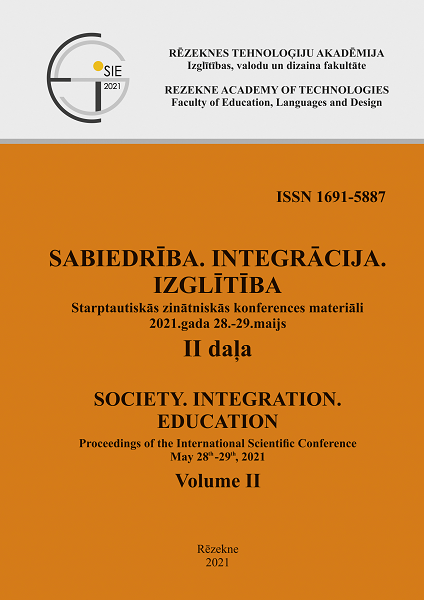METHODS OF CORRECTION BY SPEECH THERAPY IN ESTABLISHING OF VERBAL COMMUNICATION FOR NON-VERBAL CHILDREN IN PRE-SCHOOL AGE
DOI:
https://doi.org/10.17770/sie2021vol2.6465Keywords:
correction by speech therapy, creation of verbal communication, non-verbal childrenAbstract
According to the experience of many speech therapists, lately, there is a growing number of non-verbal children. Such a tendency is observed not only in special pre-school education institutions but also in general pre-school institutions. These children need the help of a speech therapist who can determine the speech therapy conclusion and choose the methods of correction. The goal of the research is to explore and analyze the effectiveness of the methods of corrections by speech therapy in the creation of verbal communication for non-verbal children in pre-school age. The correction activities consist of several stages, and as a result, children learn the skills of verbal communication and according to their abilities, use this type of communication in their daily life. Conclusions. The corrective work by speech therapy is done in a way that the speech disorder in pre-school age is eliminated or minimized. The complex impact can bring optimal results in the correction of speech disorders.Downloads
References
Cartmill, E. A., Hunsicker, D., and Goldin-Meadow, S. (2014). Pointing and naming are not redundant: children use gesture to modify nouns before they modify nouns in speech. Dev. Psychol, 50, 1660–1666. DOI: 10.1037/a0036003
Centrālā statistikas pārvalde. (2020). Bērni Latvijā. Statistisko datu krājums. Retrieved from https://www.csb.gov.lv/sites/default/files/publication/2019-08/Nr_6_Berni_Latvija_2019_%2819_00%29_LV_EN_2.pdf
Centrālā statistikas pārvalde (2020). Bērni Latvijā. Statistisko datu krājums. Retrieved from https://www.csb.gov.lv/sites/default/files/publication/2020-07/Nr_06_Berni_Latvija_2020_%2820_00%29_LV_EN.pdf
Eriksson, F. (2018). Gesture-Speech Combinations in Child Language: Form, Function, and How They Relate to Language Acquisition. Stockholm: Stockholm University.
Evans, J. L. (2007). The emergence of language: A dynamical systems account. In E. Hoff & M. Shatz (Eds.) Blackwell handbook of language development. Oxford, UK: Blackwell.
Ewig, R., Callow, J. & Rushton, K. (2016). Language and Literacy Development in Early Childhood. Cambridge: Cambridge University Press.
Gajazova, G. A., Sultanova, R. M., Shavalieva, I. (2014). Osobennosti razvitija doshkol'nikov s ONR. Iz: Logoped. Moskva: “ PIK “Idel-Press”.
Gillen, J. (2003). The Language of Children. London and New York: Routledge. Taylor & Francis Group.
Glozman, Zh. M., Potanina, A. Ju., Soboleva, A. N. (2008). Nejropsihologicheskaja diagnostika v doshkol’nom vozraste. 2 – e izdanije. Sankt-Peterburg: Piter.
Hoff, E. (2009). Language Development. New York: Wiley.
Kalinka, D. (2013). Valodas sapratnes tests. Tests bērniem no 3 līdz 5 gadu vecumam. Rīga: VISC.
Kornev, A. N. (2006). Osnovy logopatologii detskogo vozrasta: klinicheskie i psihologicheskie aspekty. Sankt-Peterburg: Rech'.
Krauze, E. (2012). Logopedija. Logopedicheskie zanjatija s det'mi rannego i srednego vozrasta. Moskva: Korona – Print.
Lūse, J., Miltiņa, I., Tūbele, S. (2012). Logopēdijas terminu skaidrojošā vārdnīca. Rīga: RaKa.
Lüke, C., Ritterfeld, U., Grimminger, A., Rohlfing, K. J., Liszkowski, U. (2020). Integrated Communication System: Gesture and Language Acquisition in Typically Children and Children With LD and DLD. Frontiers in psychology, 01 February 2020, Vol.11. DOI: 10.3389/fpsyg.2020.00118
Markus, D. (2003). Bērna valoda: no pirmā kliedziena līdz pasakai. Rīga: Rasa ABC.
Miltiņa, I. (2008). Skolotāja-logopēda darba mape. Rīga: RaKa.
Nishheva, N. V. (2009). Sistema korrekcionnoj raboty v logopedicheskoj gruppe dlja detej s obshhim nedorazvitiem rechi. Moskva: Detstvo-Press.
Rohlfing, K. J. (2019). “Learning language from the use of gestures,” in International Handbook of Language Acquisition, eds J. S. Horst, and J. von Koss Torkildsen, (New York, NY: Routledge), 213–233. DOI: 10.4324/9781315110622-12
Rowe, M. L., Özçaliskan, S., and Goldin-Meadow, S. (2008). Learning words by hand: gesture’s role in predicting vocabulary development. First Lang, 28, 182–199. DOI: 10.1177/0142723707088310
Tūbele, S. (2019). Valodas traucējumu novērtēšana. Rīga: RaKa.
Tūbele, S., Lūse, J. (2012). Ja skolēns raksta nepareizi. Rīga: RaKa.
Vizel', T. G. (2018). Nejrologopedija. Avtorskaja programma Vizel’ T. G. Povyshenie kvalifikacii. Moskvskij Institut Psihoanaliza. Retrieved from http://inpsycho.ru/edu_all/edu_add/defektologiya_/nejrologopedia/about
Vizel', T. G. (2005). Osnovy nejropsihologii. Uchebnik dlja studentov defektologicheskih i psihologicheskih fakul'tetov vuzov / T. G. Vizel'. Moskva: AST: Astrel': Tranzitkniga.
Vizel', T. G. (2016). Rebenok i ego razvitie. Moskva: V. Sekachev
Volkova, L. S. (2009). Logopedija. pod red. L.S.Volkovoj. Moskva: Vlados.
Zhukova, N. S., Mastjukova, E. M., Filicheva T. B. (2011). Logopedija. Preodolenie obshhego nedorazvitija rechi u doshkol'nikov. Moskva: ARLTD.


